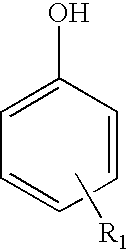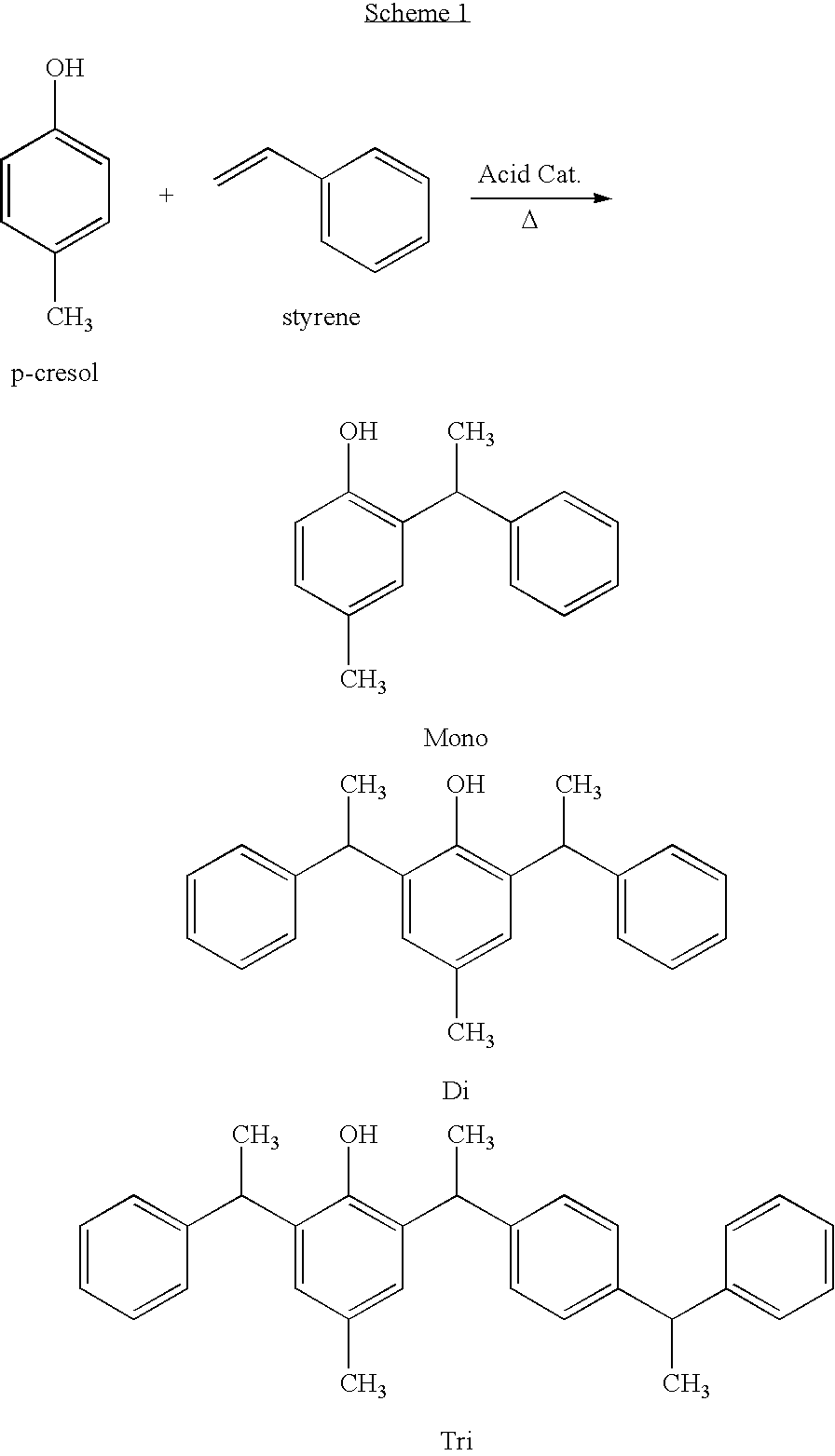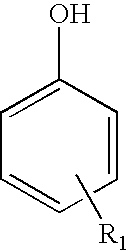Liquid styrenated phenolic compositions and processes for forming same
a technology of phenolic compositions and styrenated phenols, which is applied in the direction of chemistry apparatus and processes, fuels, impression caps, etc., can solve the problems of not always sustainable, all but impossible to transfer the compound out of the storage container, and required continuous heating
- Summary
- Abstract
- Description
- Claims
- Application Information
AI Technical Summary
Benefits of technology
Problems solved by technology
Method used
Image
Examples
example 1
Synthesis of 2,6-Distyryl-p-cresol
[0166]To a one liter round-bottomed flask equipped with a stirrer, thermometer, and addition funnel was charged 151.3 grams (1.4 moles) of p-cresol. The mixture was heated to 70° C., followed by the addition of 5 μL of trifluoromethane sulfonic acid via a 100 μL syringe. Under a nitrogen blanket, 284.5 grams (2.73 moles) of styrene was placed into the funnel and then added dropwise, with stirring, over a period of three hours. During styrene addition, the pot temperature did not exceed 80° C. Stirring was continued at a pot temperature of 70° C. for a period of 1.5 hours after all the styrene had been added. The resultant styrenated p-cresol composition analyzed as follows:
TABLE 3Gas Chromatography (GC) RESULTS (Area %)Styrene0.13p-Cresol0.03Monostyrenated p-cresol7.232,6-Distyrenated p-cresol86.31Tristyrenated p-cresol4.75Total Area98.45APHA value = 50Acid Number = 0.01 mg KOH / gBrookfield Viscosity = 29,900 cPs (25° C.)Weight Yield = 94%
example 2
[0167]This example illustrates the volatility of neat 2,6-distyryl-p-cresol, as measured by TGA. The TGA results data are summarized in Table 4. Unless otherwise indicated, thermogravimetric analysis (TGA) on neat materials was performed using a Mettler Universal V2.5H TA instrument. Weight loss was recording by isotherming the test specimens at 160° C. under nitrogen.
TABLE 4TGA Volatility of Neat 2,6-Distyryl-p-CresolWeight lossAOWeight loss(%)Molar(%) afterafter 4 hrs. @Antioxidant (AO)Mass1 hr. @ 160EC160° C.2,6-di-tert-butyl-p-cresol230100n.d.2,6-di-tert-butyl-4-sec-butyl26299n.d.phenol2,6-di-styryl-p-cresol3164094C13-15 alkyl 3,5-di-tert-butyl 471*820-4-hydroxyhydrocinnamateoctadecyl 3,5-di-tert-butyl-5310.52.54-hydroxyhydrocinnamate*estimated
[0168]These results show that neat additive volatility, as measured by TGA, line up with additive molar mass.
example 3
[0169]This example illustrates the volatiles emission from polyurethane foam additised with 2,6-distyryl-p-cresol, as measured by fog deposit. The fog test results data are summarized in Table 5.
TABLE 5Fog Deposit of Polyurethane Foam SamplesAO MolarFog deposit (mg)Antioxidant (AO)Mass@ 160 hr. / 100° C.None0.042,6-di-tert-butyl-4-sec-butyl2620.71phenol2,6-di-styryl-p-cresol3160.04C13-15 alkyl 3,5-di-tert-butyl-4- 471*0.31hydroxyhydrocinnamateoctadecyl 3,5-di-tert-butyl-4-5310.35hydroxyhydrocinnamate*estimated
[0170]These results show a surprisingly low emission for polyurethane type foam samples additised with 2,6-distyryl-p-cresol. Thus, the total fog deposit value for a 2,6-distyryl-p-cresol formulation was comparable to the no-add control. In other words, fog deposit for this formulation was significantly lower than that of two control materials that each had a higher molar mass. Moreover, surprisingly, fog deposit did not line up with the order suggested by additive molar mass.
PUM
| Property | Measurement | Unit |
|---|---|---|
| melting point | aaaaa | aaaaa |
| melting point | aaaaa | aaaaa |
| melting point | aaaaa | aaaaa |
Abstract
Description
Claims
Application Information
 Login to View More
Login to View More - R&D
- Intellectual Property
- Life Sciences
- Materials
- Tech Scout
- Unparalleled Data Quality
- Higher Quality Content
- 60% Fewer Hallucinations
Browse by: Latest US Patents, China's latest patents, Technical Efficacy Thesaurus, Application Domain, Technology Topic, Popular Technical Reports.
© 2025 PatSnap. All rights reserved.Legal|Privacy policy|Modern Slavery Act Transparency Statement|Sitemap|About US| Contact US: help@patsnap.com



